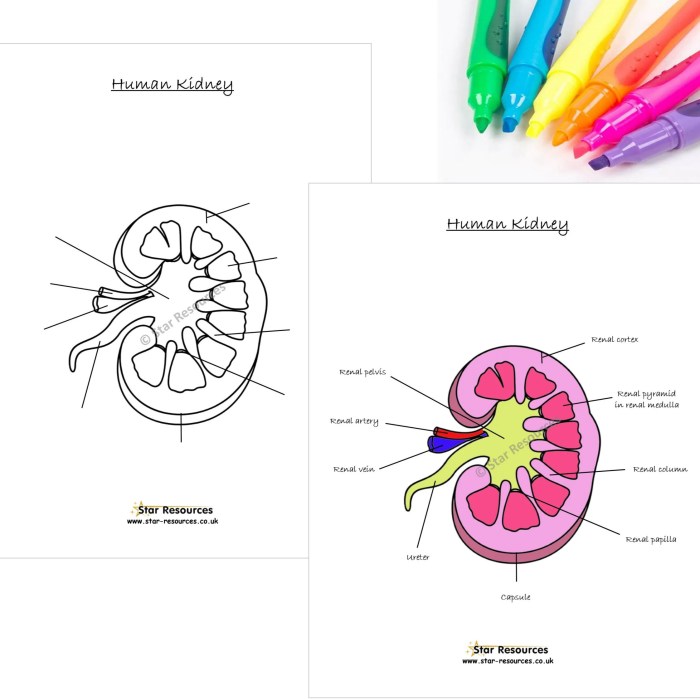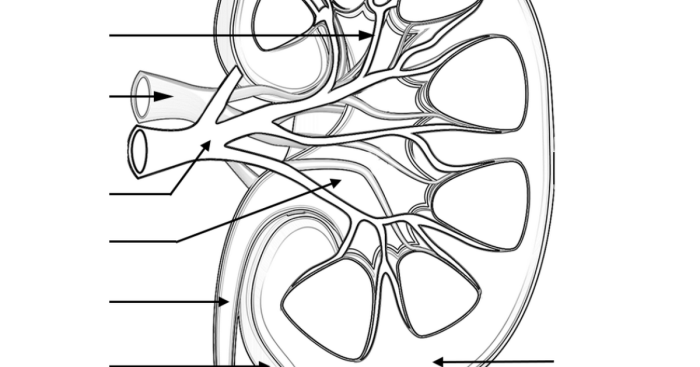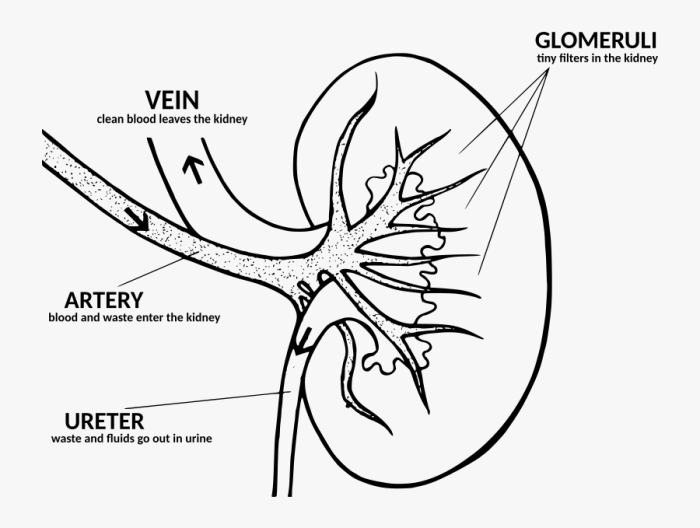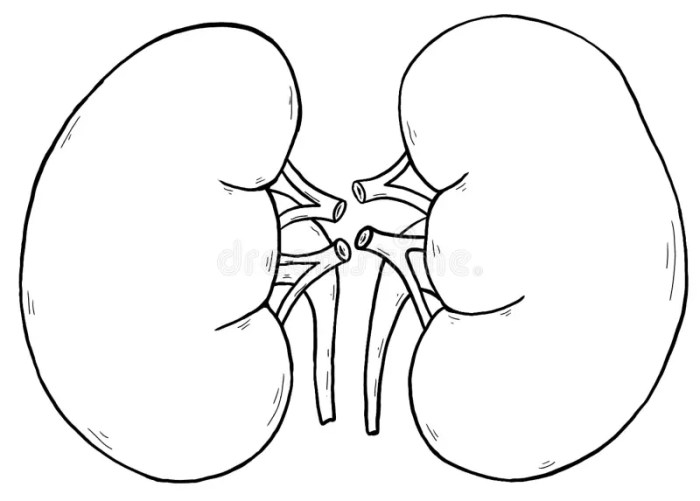Label and color the kidney: a comprehensive guide to the anatomy, function, and pathology of the kidneys, providing essential knowledge for medical professionals.
This guide delves into the intricacies of the renal system, exploring its anatomical structures, blood supply, and the vital role it plays in maintaining fluid and electrolyte balance.
Renal Anatomy: Label And Color The Kidney

The kidneys, paired bean-shaped organs, reside within the abdominal cavity, nestled behind the peritoneum and cushioned by a layer of fat. They’re strategically positioned just below the diaphragm, with the right kidney slightly lower than its left counterpart.
Externally, each kidney exhibits a convex lateral border and a concave medial border, where the renal hilum – a depression – serves as the entry point for the renal artery, exit point for the renal vein, and the passageway for the ureter.
Internally, the kidney comprises two distinct regions: the renal cortex and the renal medulla.
Renal Cortex
The renal cortex is the outermost layer of the kidney, featuring a granular texture. It houses the renal corpuscles, which are the functional units of the kidney, consisting of glomeruli (clusters of capillaries) enveloped by Bowman’s capsules.
Renal Medulla
The renal medulla lies deep to the renal cortex, showcasing a striated appearance due to the presence of renal pyramids. Each pyramid’s base faces the cortex, while its apex, known as the renal papilla, projects into the renal pelvis, a funnel-shaped cavity that collects urine.
Renal Cross-Section
A cross-section of the kidney reveals its intricate internal structure:
- Renal Cortex: The outermost layer, containing the renal corpuscles.
- Renal Medulla: The inner layer, comprising renal pyramids.
- Renal Pelvis: The funnel-shaped cavity collecting urine.
- Renal Pyramids: Cone-shaped structures within the medulla, with their apices pointing towards the renal pelvis.
- Renal Papillae: The tips of the renal pyramids, projecting into the renal pelvis.
- Renal Calyces: Minor and major cup-like structures that collect urine from the renal papillae and deliver it to the renal pelvis.
- Renal Column: Extensions of the renal cortex that project into the renal medulla, separating the renal pyramids.
Renal Blood Supply

The kidneys receive their blood supply from the renal arteries, which branch off from the abdominal aorta. The renal arteries enter the kidneys at the hilum and then divide into smaller branches that supply blood to the different parts of the kidney.
Understanding the anatomy of the kidney is crucial for labeling and coloring it accurately. While we delve into this topic, let’s take a quick detour to explore the Flying J 763 in Rawlins, Wyoming . This renowned truck stop offers a wide range of amenities for travelers, making it a popular rest stop along major highways.
Returning to our discussion, let’s continue exploring the intricacies of labeling and coloring the kidney to gain a comprehensive understanding of its structure.
Arterial Supply
- Renal Arteries:The renal arteries are the main arteries that supply blood to the kidneys. They arise from the abdominal aorta, just below the level of the superior mesenteric artery.
- Segmental Arteries:The renal arteries divide into five segmental arteries, which supply blood to the different segments of the kidney.
- Interlobar Arteries:The segmental arteries further divide into interlobar arteries, which run between the renal pyramids.
- Arcuate Arteries:The interlobar arteries give rise to arcuate arteries, which run along the corticomedullary junction.
- Interlobular Arteries:The arcuate arteries give rise to interlobular arteries, which run up through the renal cortex.
- Afferent Arterioles:The interlobular arteries give rise to afferent arterioles, which enter the glomeruli.
Venous Drainage
- Renal Veins:The renal veins are the main veins that drain blood from the kidneys. They arise from the hilum of the kidney and then join to form the renal vein, which drains into the inferior vena cava.
- Segmental Veins:The renal veins divide into segmental veins, which drain blood from the different segments of the kidney.
- Interlobar Veins:The segmental veins further divide into interlobar veins, which run between the renal pyramids.
- Arcuate Veins:The interlobar veins give rise to arcuate veins, which run along the corticomedullary junction.
- Interlobular Veins:The arcuate veins give rise to interlobular veins, which run up through the renal cortex.
- Efferent Venules:The interlobular veins receive blood from the efferent venules, which leave the glomeruli.
Renal Function

The kidneys play a crucial role in maintaining the body’s fluid and electrolyte balance, ensuring proper hydration and the optimal functioning of cells and organs.
Glomerular Filtration, Label and color the kidney
Glomerular filtration is the initial step in urine formation, where blood is filtered through tiny filters called glomeruli in the renal corpuscles. This process removes waste products, excess ions, and excess water from the blood, creating a filtrate that contains essential nutrients and ions.
Tubular Reabsorption
As the filtrate passes through the renal tubules, essential substances like glucose, amino acids, and sodium ions are selectively reabsorbed back into the bloodstream. This process ensures the body retains vital nutrients and maintains electrolyte balance.
Tubular Secretion
Tubular secretion is the active transport of certain substances from the bloodstream into the renal tubules. This process helps eliminate waste products, such as creatinine and hydrogen ions, and regulate blood pH.
Urine Formation Flowchart
The following flowchart illustrates the steps involved in urine formation:
- Glomerular Filtration:Blood is filtered through the glomeruli, creating a filtrate containing waste products and excess water.
- Tubular Reabsorption:Essential substances are selectively reabsorbed back into the bloodstream from the filtrate.
- Tubular Secretion:Waste products are actively transported from the bloodstream into the tubules.
- Urine Formation:The remaining filtrate, now concentrated and containing waste products, forms urine.
Renal Pathology

Renal pathology encompasses a spectrum of diseases that affect the kidneys, impairing their function and leading to various clinical manifestations. Understanding these conditions is crucial for healthcare professionals to provide appropriate diagnosis and treatment.
Glomerulonephritis
Glomerulonephritis refers to inflammation of the glomeruli, the tiny filtering units within the kidneys. It can be caused by various factors, including infections, autoimmune disorders, and genetic conditions.
- Symptoms:Glomerulonephritis typically presents with proteinuria (excessive protein in urine), hematuria (blood in urine), edema (fluid retention), and hypertension (high blood pressure).
- Diagnosis:Diagnosis involves urine and blood tests, imaging studies, and kidney biopsy.
- Treatment:Treatment depends on the underlying cause and may include medications, immunosuppressive therapy, and dialysis.
Pyelonephritis
Pyelonephritis is an infection of the kidney’s pelvis and parenchyma. It is commonly caused by bacterial infections ascending from the lower urinary tract.
- Symptoms:Pyelonephritis typically presents with fever, chills, flank pain, and urinary frequency and urgency.
- Diagnosis:Diagnosis involves urine and blood tests, imaging studies, and urine culture.
- Treatment:Treatment typically involves antibiotics, pain relievers, and hydration.
Kidney Stones
Kidney stones are solid deposits of minerals and salts that form in the kidneys. They can cause significant pain and obstruction of the urinary tract.
- Symptoms:Kidney stones typically present with severe flank pain, nausea, and vomiting. They can also cause urinary obstruction, leading to difficulty urinating.
- Diagnosis:Diagnosis involves imaging studies, such as ultrasound or CT scan.
- Treatment:Treatment options include pain management, medical therapy to dissolve small stones, and surgical intervention for larger stones.
Commonly Asked Questions
What is the function of the kidneys?
The kidneys are responsible for filtering waste products from the blood, regulating fluid and electrolyte balance, and producing urine.
What are the common types of kidney diseases?
Common kidney diseases include glomerulonephritis, pyelonephritis, and kidney stones.
How are kidney diseases diagnosed?
Kidney diseases are typically diagnosed through blood tests, urine analysis, and imaging studies.
